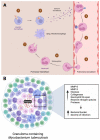Neutrophils in Mycobacterium tuberculosis
- PMID: 36992214
- PMCID: PMC10055476
- DOI: 10.3390/vaccines11030631
Neutrophils in Mycobacterium tuberculosis
Abstract
Mycobacterium tuberculosis (M. tb) continues to be a leading cause of mortality within developing countries. The BCG vaccine to promote immunity against M. tb is widely used in developing countries and only in specific circumstances within the United States. However, current the literature reports equivocal data on the efficacy of the BCG vaccine. Critical within their role in the innate immune response, neutrophils serve as one of the first responders to infectious pathogens such as M. tb. Neutrophils promote effective clearance of M. tb through processes such as phagocytosis and the secretion of destructive granules. During the adaptative immune response, neutrophils modulate communication with lymphocytes to promote a strong pro-inflammatory response and to mediate the containment M. tb through the production of granulomas. In this review, we aim to highlight and summarize the role of neutrophils during an M. tb infection. Furthermore, the authors emphasize the need for more studies to be conducted on effective vaccination against M. tb.
Keywords: Mycobacterium tuberculosis; immune system; infection; neutrophils; tuberculosis.
Conflict of interest statement
The authors declare no conflict of interest.
Figures


References
-
- WHO Tuberculosis. 27 October 2022. [(accessed on 2 January 2023)]. Available online: https://www.who.int/news-room/fact-sheets/detail/tuberculosis.
-
- Formad H.F. The Etiology of Tuberculosis. J. Am. Med. Assoc. 1882;IV:312–316. doi: 10.1001/jama.1885.02390870004001a. - DOI
-
- CDC . Tuberculosis General Information Fact Sheet. CDC; Atlanta, GA, USA: 2011.
-
- Long R., Divangahi M., Schwartzman K. Chapter 2: Transmission and pathogenesis of tuberculosis. Can. J. Respir. Crit. Care Sleep Med. 2022;6:22–32. doi: 10.1080/24745332.2022.2035540. - DOI
Publication types
LinkOut - more resources
Full Text Sources

